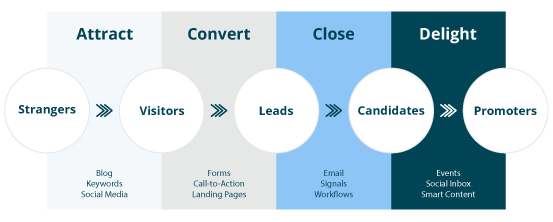Have you ever felt like you're doing everything you can to close a sale, but it just doesn't seem to work? It's frustrating, isn't it? The good news is that there is a solution: sales enablement.
Sales enablement provides your sales team with the tools, resources, and information they need to sell more effectively. It's a strategic approach to sales that focuses on empowering your sales team to close more deals.
HubSpot reports that businesses with effective sales and marketing alignment achieved 208% higher marketing revenue than organizations with disjointed teams.
If you're struggling to close deals, then sales enablement is something you need to consider.
In this article, we'll examine what sales enablement is, why it's important, and how you can implement it in your organization to close more deals. So, let's get started!
|
Sales enablement Sales enablement is the iterative process of providing your business's sales team with the resources they need to close more deals. |
What is Sales Enablement?
Sales enablement is a strategic approach that equips sales teams with the resources, tools, and knowledge they need to effectively engage with prospects and close deals.
It focuses on aligning marketing and sales efforts, optimizing sales processes, and empowering sales professionals to deliver value to customers at every stage of the buyer's journey.
Here are the key components of a successful sales enablement strategy:
Sales and Marketing Alignment
Sales and marketing alignment is the foundation of effective sales enablement. When sales and marketing teams work together seamlessly, it leads to improved communication, shared goals, and a unified approach to engaging prospects and closing deals.
Buyer Personas and Customer Insights
Developing detailed buyer personas and gaining deep customer insights are essential for effective sales enablement. By understanding your target audience's pain points, motivations, and buying behaviours, you can tailor your sales approach to resonate with their needs and preferences.
Compelling Sales Content
Sales content plays a crucial role in engaging prospects and guiding them through the buyer's journey. Whether it's sales presentations, proposals, case studies, or testimonials, your sales content should be persuasive, informative, and tailored to address specific buyer pain points.
Sales Enablement Technology
Leveraging sales enablement tools and technology can streamline your sales processes, enhance productivity, and provide valuable insights. Sales enablement platforms, customer relationship management (CRM) systems, and analytics tools are just a few examples of technology that can optimize your sales efforts.
By implementing these key components, you can create a robust sales enablement strategy that empowers your team to achieve exceptional results.
Why Sales Enablement is Important
In today's competitive business landscape, sales enablement has emerged as a critical factor in driving sales success and achieving revenue growth. It goes beyond traditional sales approaches by equipping your sales team with the right tools, knowledge, and resources to engage buyers effectively and close deals.
Here are key reasons why sales enablement is crucial for your organization:
1. Increased Sales Performance
Sales enablement empowers your sales team to perform at their best. By providing them with comprehensive training, valuable insights, and relevant resources, you enhance their ability to engage prospects, address their pain points, and deliver persuasive solutions.
This leads to higher conversion rates, increased deal sizes, and ultimately, improved sales performance.
2. Enhanced Buyer Experience
Sales enablement places the buyer at the centre of the sales process. It ensures that your team has a deep understanding of your target audience, their needs, and their journey.
By aligning your sales approach with buyer preferences and delivering personalized, relevant content, you create a positive buyer experience that builds trust and increases the likelihood of closing deals.
3. Sales and Marketing Alignment
Effective sales enablement fosters alignment between sales and marketing teams. When these two departments work together seamlessly, it results in a cohesive approach to engaging prospects and nurturing relationships.
Aligned sales and marketing efforts lead to higher-quality leads, improved lead conversion rates, and a more efficient sales process overall.
4. Streamlined Sales Processes
Sales enablement streamlines and optimizes sales processes, eliminating inefficiencies and maximizing productivity. It provides your team with access to sales enablement technologies, such as customer relationship management (CRM) systems and sales automation tools, which automate manual tasks, track customer interactions, and provide valuable insights for informed decision-making.
5. Continuous Learning and Development
Sales enablement promotes a culture of continuous learning and development within your sales team. Through ongoing training programs, coaching sessions, and access to industry insights, you empower your sales representatives to stay updated on the latest sales techniques, market trends, and product knowledge.
This enables them to adapt to changing buyer preferences and deliver exceptional value to prospects.
6. Competitive Advantage
In a crowded marketplace, having a well-executed sales enablement strategy can give your organization a competitive edge.
By equipping your sales team with the right tools, knowledge, and resources, you differentiate yourself from competitors and position your organization as a trusted advisor and solution provider. This sets you apart and increases your chances of winning deals.
By investing in sales enablement, you unlock the potential of your sales team, improve customer engagement, and drive revenue growth. It is a strategic approach that yields tangible results and positions your organization for long-term success in today's dynamic sales environment.
How to Close More Deals with Sales Enablement
Sales enablement (SE) is all about equipping your sales team with the relevant content and tools so that they can not just focus on the better-quality leads, but also be able to close them. It’s about helping your sales team become more productive and efficient.
1. Aligning Sales and Marketing Efforts for Sales Enablement Success
Sales and marketing alignment is a crucial factor in driving sales enablement success. When these two departments work harmoniously towards shared goals, it results in improved collaboration, streamlined processes, and a cohesive approach to engaging prospects and closing deals.
Clear Communication and Shared Objectives
Effective sales enablement starts with establishing clear lines of communication between sales and marketing teams. Regular meetings, joint planning sessions, and open channels of communication foster collaboration and ensure that both teams are on the same page.
By aligning objectives and setting shared goals, sales and marketing teams can work together towards common targets, such as increasing revenue, acquiring new customers, or penetrating new markets.
Buyer Persona Development
Creating detailed buyer personas is a critical aspect of sales enablement. Collaboratively developing buyer personas helps align sales and marketing efforts towards understanding the target audience's pain points, motivations, and preferences.
By gaining a deep understanding of the ideal customer profile, sales teams can tailor their messaging, sales content, and approaches to resonate with the needs and challenges of potential buyers.
Content Collaboration
Effective sales enablement requires collaboration between sales and marketing teams in creating compelling sales content. Marketing professionals possess expertise in crafting engaging and informative content, while sales teams bring valuable insights from their interactions with prospects and customers.
By combining their knowledge and expertise, sales and marketing teams can develop impactful sales collateral, such as sales presentations, case studies, whitepapers, and blog posts, that effectively address buyer pain points and accelerate the sales process.
Continuous Training and Education
Sales enablement also involves providing ongoing training and education to the sales team to enhance their skills and keep them up to date with industry trends and best practices. Marketing professionals can contribute by delivering training sessions or creating educational resources that empower the sales team with product knowledge, sales techniques, objection-handling strategies, and industry insights.
By investing in the professional development of the sales team, you ensure that they are equipped with the necessary skills and knowledge to excel in their roles.
Closed-Loop Feedback and Data Analysis
Sales and marketing alignment is further strengthened by establishing a closed-loop feedback system. Regular communication and data sharing enables marketing teams to gather valuable insights from the sales team's experiences in the field.
This feedback loop helps you refine their strategies, improve lead-generation efforts, and optimize marketing campaigns based on real-world sales outcomes. Likewise, sales teams benefit from marketing data analysis, which provides them with valuable insights into prospect behaviour, lead quality, and the effectiveness of marketing initiatives.
By aligning sales and marketing efforts, you create a cohesive and customer-centric approach that drives sales enablement success. The collaboration between these two departments ensures that marketing initiatives generate qualified leads and relevant content, while the sales team receives the necessary support and resources to engage prospects effectively and close deals.
2. Developing Buyer Personas and Customer Insights
Understanding the target audience is paramount in sales enablement. Marketing professionals play a crucial role in developing detailed buyer personas and gathering customer insights to support sales engagement efforts.
Creating buyer personas involves going beyond surface-level demographics and understanding the motivations, needs, pain points, and buying behaviours of potential customers. You can conduct market research, analyze customer data, and engage in customer interviews to gather the necessary insights.
By developing buyer personas and gathering customer insights, marketing professionals equip the sales team with the knowledge and understanding necessary to engage potential customers effectively.
These insights enable sales professionals to tailor their messaging, positioning, and solutions to match the unique needs and preferences of their prospects, resulting in more successful sales interactions and higher conversion rates.
3. Creating Compelling Sales Content
When it comes to sales enablement, creating compelling sales content is a critical component that marketing professionals need to master. Sales content serves as a powerful tool to engage prospects, communicate value, and drive them towards making a purchasing decision.
To create compelling sales content, you should start by understanding the buyer's journey. Mapping out the stages of the buyer's journey, from awareness to consideration and decision, helps in tailoring the content to meet the specific needs and interests of prospects at each stage.
Storytelling
Storytelling techniques play a crucial role in capturing the attention and interest of prospects. Human beings are wired to respond to stories, so incorporating narratives into sales content can be highly effective.
By sharing success stories, case studies, and customer testimonials, marketing professionals can illustrate how their product or service has solved similar challenges for other customers.
This not only builds credibility but also creates an emotional connection with the prospects, increasing the likelihood of them moving forward in the sales process.
Personalization
Another essential aspect of creating compelling sales content is personalization. Generic, one-size-fits-all content is less likely to resonate with prospects.
You should leverage the buyer personas and customer insights developed earlier to customize the content to match the specific needs, pain points, and preferences of individual prospects.
This personalized approach demonstrates that you understand their unique challenges and positions your offering as the ideal solution.
Visual elements
Visual elements also play a significant role in capturing attention and conveying information effectively. Incorporating visually appealing graphics, charts, and infographics into sales presentations and proposals can help simplify complex concepts and make the content more engaging.
Also, using multimedia formats, such as videos or interactive presentations, can create a memorable and immersive experience for prospects.
Value
Lastly, you should focus on creating content that highlights the value and benefits of their product or service. It's essential to communicate how your offering solves the prospect's pain points, addresses their specific needs, and delivers measurable results.
Use compelling data, statistics, and customer success stories to reinforce the value proposition and build trust in your offering.
By investing time and effort in creating compelling sales content, you provide the sales team with powerful tools to engage prospects, differentiate their offerings, and ultimately close more deals. Remember, effective sales content is not just about providing information; it's about creating a persuasive narrative that resonates with prospects and compels them to take action.
4. Leveraging Sales Enablement Technology
In today's digital age, sales enablement technology plays a crucial role in empowering sales teams and driving successful deal closures. These advanced tools and platforms are designed to streamline and enhance various aspects of the sales process.
By leveraging sales enablement technology like HubSpot, you can provide the sales teams with the necessary resources and capabilities to excel in their roles.
Sales enablement technology encompasses a wide array of tools and platforms available in the market. These tools offer unique features and functionalities to support different stages of the sales journey.

When selecting sales enablement technology, consider the specific needs and objectives of your sales team. Assess your sales processes and identify areas where technology can make a significant impact.
Look for tools that offer seamless integration with existing systems, user-friendly interfaces, robust analytics capabilities, and scalability to accommodate future growth. Thorough research, reading reviews, and seeking recommendations from industry experts can help you make an informed decision.
5. Empowering the Sales Team
Empowering the sales team is a critical component of successful sales enablement. It involves providing them with the necessary knowledge, skills, tools, and resources to excel in their roles.
By investing in comprehensive sales training and development programs, you can equip your sales teams with the expertise and confidence to engage prospects effectively, address objections, and close deals.
Arming the sales team with the right tools and resources is crucial for their success. Sales enablement technology plays a significant role in this aspect, providing easy access to up-to-date sales collateral, presentations, case studies, and product information.
Additionally, marketing professionals should collaborate with the sales team to understand their specific requirements and provide tailored content and resources that resonate with prospects throughout the buyer's journey.
Implementing effective sales coaching and mentorship programs can greatly impact the performance and growth of sales professionals. Pairing experienced sales leaders or mentors with junior team members creates opportunities for knowledge transfer, skill development, and guidance.
Regular coaching sessions, performance feedback, and goal-setting exercises help salespeople continuously improve their abilities and refine their sales strategies.
6. Streamlining the Sales Process
Streamlining the sales process is essential for optimizing efficiency and driving successful deal closures. By mapping out the sales process and identifying areas of improvement, you can implement strategies and automation to eliminate bottlenecks and enhance productivity.
Start by analyzing the existing sales process and identifying the key stages, activities, and touchpoints involved. Map out a clear flow that aligns with your target customer's journey.
Identify any inefficiencies or areas where the process can be streamlined. Implement automation tools and workflows to eliminate manual tasks, reduce errors, and improve overall efficiency. Regularly review and refine the sales process based on data and feedback to ensure continuous improvement.
By leveraging sales enablement technology, empowering the sales team, and streamlining the sales process, you can master the art of closing deals and achieving greater success in your sales efforts.
These strategies and techniques, when implemented effectively, will enable you to drive better results, enhance collaboration between sales and marketing teams, and ultimately achieve their sales objectives.
7. Implementing Sales Enablement Analytics
Implementing sales enablement analytics is crucial for monitoring and measuring the effectiveness of your sales enablement efforts. By tracking key sales performance metrics and analyzing data, you can gain valuable insights to optimize your sales strategies and drive better results.
Start by identifying the key performance indicators (KPIs) that align with your sales enablement goals. These may include metrics such as conversion rates, win rates, average deal size, sales cycle length, and customer acquisition cost. Implement tools and systems that can track and collect relevant data to provide you with a comprehensive view of your sales performance.
Leverage analytics to gain insights into the effectiveness of your sales content, presentations, and collateral. Determine which assets are resonating most with prospects and driving successful conversions. Use A/B testing and data analysis to optimize your sales materials and improve their impact on prospects.
Analyze the data to identify trends, patterns, and areas for improvement in your sales process. Look for bottlenecks, roadblocks, or gaps in your sales enablement strategy that may be hindering deal closures. Use the insights gained from analytics to make data-driven decisions and implement targeted improvements to streamline the sales process and drive better outcomes.
8. Nurturing Relationships and Overcoming Objections
Building strong relationships with prospects and clients is essential for closing deals successfully. A key aspect of sales enablement is providing sales teams with the tools and techniques to nurture relationships throughout the sales journey.
Develop a personalized approach to engage prospects based on their specific needs and pain points. Utilize the customer insights and buyer personas developed earlier to tailor your sales messaging and outreach.
Provide value-added content and resources that address their challenges and demonstrate your expertise.
Addressing objections is another crucial aspect of successful deal closures. Equip your sales team with objection-handling techniques and strategies to overcome common objections effectively.
9. Continuous Learning and Improvement
Continuous learning and improvement are essential for mastering the art of closing deals with sales enablement. Encourage a culture of continuous learning within your sales team and provide opportunities for professional development.
Implement feedback loops and performance evaluations to provide constructive feedback and identify areas for improvement. Conduct regular sales meetings and debriefs to share best practices, lessons learned, and success stories.
Encourage collaboration and knowledge sharing among team members to foster a culture of continuous improvement.
Stay updated on industry trends, best practices, and emerging sales enablement strategies. Attend industry conferences, webinars, and workshops to expand your knowledge and network with other professionals.
Invest in ongoing training and certifications for your sales team to keep their skills sharp and up-to-date.
Close More Deals with Sales Enablement
As a marketing professional, you understand the significance of closing deals effectively in today's competitive business landscape. It is crucial to master the art of sales enablement to drive remarkable sales results.
Sales enablement provides you with a strategic approach that empowers your sales team with the right tools, techniques, and resources to engage prospects and guide them through the sales journey successfully.
By aligning your sales and marketing efforts you can elevate your sales game and achieve greater success in closing deals.
Now is the time to take your sales enablement efforts to the next level. Partner with a trusted sales enablement provider like Fine Media to supercharge your sales strategy and help you achieve remarkable results.
Our team of experts has the knowledge and experience to guide you through aligning your sales and marketing efforts, developing effective content, implementing the right tools, streamlining your sales process, and achieving sales excellence.
Contact Fine Media today and let us be your partner in mastering the art of closing deals.



